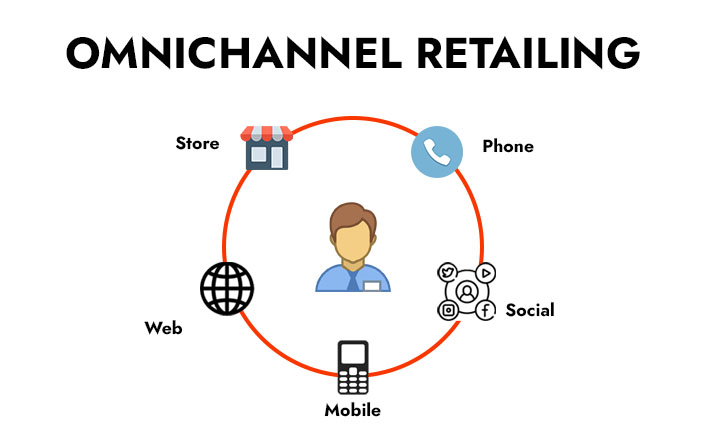
In today’s ever-evolving retail landscape, consumers are demanding seamless and personalized shopping experiences across various channels. Omnichannel retail marketing strategy has emerged as a powerful solution to meet these demands and stay ahead in the competitive market. This blog aims to explore how WooCommerce, a popular E-commerce platform, can be harnessed to master the art of omnichannel retail.
Omnichannel retail is a holistic approach that aims to create a unified and consistent shopping experience for customers across all touchpoints, whether they are shopping in physical stores, browsing a website, using a mobile app, engaging with social media, or exploring online marketplaces. It focuses on breaking down the barriers between different channels and seamlessly integrating them to provide customers with convenience and flexibility.
Importance of Adopting an Omnichannel Approach
The modern consumer is not bound by a single shopping channel. They expect brands to understand their preferences and provide a cohesive experience, regardless of how they choose to interact with the business. Adopting an omnichannel strategy is crucial for businesses looking to enhance customer satisfaction, boost loyalty, increase conversions, and ultimately, drive revenue growth.
Overview of WooCommerce as an E-commerce Platform
WooCommerce is a powerful and widely-used E-commerce platform built on WordPress. With its user-friendly interface and robust features, it empowers businesses to set up and manage online stores efficiently. Its flexibility and extensive plugin ecosystem make it an ideal choice for retailers seeking to implement an omnichannel retail strategy.
As we delve deeper into this blog, we will explore the various components of omnichannel retail and how WooCommerce can be integrated seamlessly into the process. From understanding consumer behavior and creating a unified shopping experience to managing inventory, utilizing data analytics, and providing exceptional customer support, we will equip you with the knowledge and tools to master omnichannel retail with WooCommerce.
Steps to Formulate an Omnichannel Retail Strategy with WooCommerce
Defining the Customer Journey
The first step in crafting a powerful omnichannel retail strategy using WooCommerce is to define your customer’s journey. Understanding the entire trajectory of their interactions with your brand, from initial contact to final purchase, is essential. This understanding enables you to deliver a seamless and consistent experience across all channels and platforms.

Identify each touchpoint your customers encounter during their interaction with your brand, whether online or offline. This includes visiting your website, engaging with email newsletters, interacting with social media accounts, or visiting physical stores, if applicable. Recognize that a customer’s journey may not always be linear, and they might move between channels before completing a purchase.
Next, seek opportunities to create omnichannel integrations. Connect these touchpoints to provide a unified experience for customers. For instance, if a customer views a product on your website but doesn’t make a purchase, use email marketing to send them a personalized reminder or related offer. Linking online and offline experiences can also be achieved by allowing customers to check product availability online and opt for in-store pickup.
Crafting an Effective Product Presentation Strategy
Once you comprehend your customer’s journey, the next step is to devise a strategic product presentation approach. Product presentation significantly influences sales, making it a critical aspect of your omnichannel strategy. One impactful method is to showcase related products.

Displaying related products encourages customers to explore additional offerings, increasing the likelihood of supplementary purchases. These related products could be complementary items, similar products, or items commonly bought together. For instance, if a customer is browsing for a laptop, they might also be interested in laptop cases, a mouse, or software packages.
WooCommerce provides built-in functionality to display related products using product categories and tags. For a more personalized approach, consider integrating additional plugins.
Leveraging Educational Content and Webinars
Educational content, particularly webinars, plays a pivotal role in engaging customers and driving sales in your omnichannel strategy. Webinars offer valuable content to your audience, ranging from product demonstrations and tutorials to expert discussions. They establish your authority, build trust, and gently guide potential customers toward making a purchase.

Webinars also serve as an opportunity to showcase your products or services without a hard-sell approach. For instance, a webinar can demonstrate how to use a specific product, providing valuable insights without being overly promotional. The interactive nature of webinars allows real-time engagement, addressing customer queries and concerns instantly.
To sell webinars through WooCommerce, consider plugins such as “WooCommerce Paid Events” or “WooCommerce Bookings,” allowing you to create and sell webinar tickets. Promote the webinar across various channels, and follow up with attendees using email or SMS reminders, reinforcing a seamless shopping experience.
Selecting the Right Plugins
WooCommerce’s extensive plugin ecosystem plays a pivotal role in supporting a successful omnichannel strategy. Plugins extend your WooCommerce store’s functionality to cater to specific business needs and goals.
When choosing plugins, consider the functionality they offer, compatibility with your current WooCommerce version and other plugins, developer support and updates, and user reviews and ratings. Avoid overloading your site with unnecessary plugins to ensure optimal performance.
Integrating with Social Media Platforms
Social media platforms are not just marketing channels but also significant discovery and commerce hubs. Integrating your WooCommerce store with social media platforms enhances the shopping experience and drives customer engagement and conversions.
Integrating social media primarily involves social media marketing and social commerce. Social media marketing entails sharing engaging content, responding to customer inquiries, and running paid campaigns. Social commerce enables selling directly through social media platforms.

Consider plugins such as “Facebook for WooCommerce” to connect your WooCommerce store with your Facebook page, syncing product catalogs and enabling Messenger integration. To ensure a consistent brand experience, maintain uniform branding, messaging, and customer service across all platforms.
Leveraging Multi-Channel Marketing
Multi-channel marketing is vital for a seamless customer experience in your omnichannel strategy. Utilize various channels, such as email marketing, content marketing, SEO, and social media marketing, to deliver a cohesive message to customers.
- Email Marketing: Automate personalized email campaigns using WooCommerce’s integration with email marketing services like Mailchimp or SendinBlue.
- Content Marketing: Combine your WooCommerce store with a content-rich website to drive traffic using blog posts, tutorials, webinars, and other valuable content.
- SEO: Optimize your product pages, categories, and tags for higher search engine rankings using plugins like Yoast SEO.
- Other Digital Marketing Channels: Utilize plugins like “WooCommerce Google Ads” and “WooCommerce Social Media Share Buttons” to leverage Google’s advertising network and social media platforms for promotion.
Ensure your messaging remains consistent across all channels to reinforce the omnichannel shopping experience.
Streamlining Inventory Management Across Channels
Real-time inventory tracking is critical for a successful omnichannel strategy, as customers expect consistent product availability across all channels. Employ plugins like WooMultistore to sync inventory levels across different sales channels, preventing overselling and stockouts.
Implementing Seamless Customer Service
Customer service is integral to an effective omnichannel strategy. Integrate a help desk plugin, such as WPHelpDesk or Help Scout Desk, to manage and respond to customer queries efficiently. Offer live chat support and utilize chatbots for automated responses. For social media queries, use tools like Buffer or Hootsuite to manage interactions in one place.
Consider holistic customer service platforms like Zendesk or Freshdesk, which consolidate interactions from various channels into one dashboard for efficient management.
Managing WooCommerce Invoices
Efficient invoice management is crucial for accounting, customer service, and legal compliance. WooCommerce provides built-in invoice features, but consider using plugins to enhance functionality, such as custom invoice templates or automated invoicing.
Case Studies of Successful Omnichannel Retailers with WooCommerce
Real-life Examples of Companies Implementing Omnichannel Strategies:
TechGadgets Co. – Seamless In-Store and Online Experience TechGadgets Co., a leading electronics retailer, successfully implemented an omnichannel strategy using WooCommerce. Their brick-and-mortar stores were seamlessly integrated with their online platform, allowing customers to browse products online and make purchases in-store or vice versa. They offered a “Click and Collect” option, enabling customers to order online and pick up their purchases at their nearest store, enhancing convenience. By utilizing WooCommerce’s robust inventory management and order fulfillment features, TechGadgets Co. ensured that stock levels were synchronized across all channels, reducing the risk of overstocking or stockouts. This omnichannel approach resulted in a 30% increase in sales within the first year of implementation.
FashionForward – Personalized Recommendations and Social Integration FashionForward, a fashion retailer, embraced an omnichannel approach with a strong focus on personalization. They leveraged WooCommerce’s extensive plugin ecosystem to integrate artificial intelligence (AI) algorithms, enabling them to provide personalized product recommendations based on individual customer preferences and browsing history. Additionally, FashionForward actively engaged customers on social media platforms by integrating social media feeds and user-generated content into their WooCommerce-powered website. This strategy fostered a sense of community and authenticity, leading to a 25% increase in social media-driven conversions and a 20% boost in overall revenue.
Lessons Learned and Takeaways from Their Success:
Customer-Centric Approach: Both TechGadgets Co. and FashionForward prioritized their customers’ needs and preferences throughout their omnichannel strategies. They utilized customer data to offer personalized experiences, making customers feel valued and understood.
Seamless Integration: Successful omnichannel retailers ensure smooth integration between various sales channels. By using WooCommerce as a central hub, they synchronized inventory, pricing, and customer data across all touchpoints, providing a consistent experience.
Embracing Technology: Leveraging the power of technology, especially AI and social media integration, allowed these retailers to stay ahead of the curve. Integrating cutting-edge tools with WooCommerce helped them deliver innovative and engaging experiences.
Data-Driven Decision Making: Both case studies highlight the importance of data-driven decision-making. By analyzing customer behavior and performance metrics, these retailers were able to identify areas for improvement and optimize their strategies continuously.
Agility and Adaptability: The retail landscape is dynamic, and successful omnichannel retailers are agile in adapting to changes and emerging trends. They embrace new technologies, stay abreast of customer preferences, and adjust their strategies accordingly.
These case studies demonstrate the power of omnichannel retailing when paired with WooCommerce. By focusing on customer-centricity, seamless integration, technological advancements, and data-driven decision-making, retailers can achieve remarkable success and elevate their businesses to new heights. As you embark on your own omnichannel journey with WooCommerce, keep these valuable lessons in mind and pave the way for a thriving and profitable future in the competitive retail industry.
Thriving with Your Omnichannel Strategy
Implementing an effective omnichannel retail strategy with WooCommerce is paramount for modern retail success. By leveraging WooCommerce’s features, integrations, and plugins, you can provide a seamless shopping experience for customers across multiple channels.
By following the strategies outlined in this article, you can establish a powerful omnichannel retail presence, reach customers wherever they are, provide personalized experiences, streamline operations, and drive sales. WooCommerce’s adaptability and the support of various plugins and tools make it easier than ever to evolve your omnichannel strategy and stay ahead of the competition.
